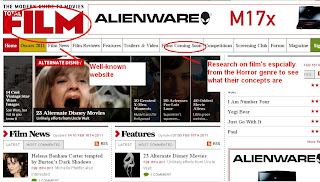
Wednesday, 9 February 2011
Tuesday, 8 February 2011
Question 4 - How did you use media technologies in the construction and researh, planning, production and post production stages?
 Google was one of the main media technologies we used to get ideas for posters and magazine. We decided to use Google rather than look on news stands as they have the latest magazines covers on media technologies such as Google images. Also through the use of editing and improved technol ogies such as Canon cameras, the quality of the magazine covers has improved. On Google this would be easier to access than going into shops as that’s time wasting.
Google was one of the main media technologies we used to get ideas for posters and magazine. We decided to use Google rather than look on news stands as they have the latest magazines covers on media technologies such as Google images. Also through the use of editing and improved technol ogies such as Canon cameras, the quality of the magazine covers has improved. On Google this would be easier to access than going into shops as that’s time wasting.Searching for exisitng teaser trailers was hard at some points as some were fan made or was more than 60 seconds. There were popular teasers such as Scream 4, Scary Movie and A Nightmare On Elm Street. Youtube was useful becuase we could rewind the video to see what parts of the trailer we liked and if we saw any ideas hat we wanted to take note of.
Here some of the comments on what people thought about the film. I felt this was good to look at as we could see what people are a specific target group were looking for in a horror film .
This also expanded our knowledge on Horror movies because we were able to get different ideas other the giving a similar idea of a horror movie that everybody is familiar with. Looking at popular teaser trailers such as Scream, Saw and Friday 13th we wanted to see what shots were popular with many of these horror movies such as fast cuts and a dark colour palette.This helped for a our trailer to be familiar with the audience as they would recongnise the convetions of horror teaser trailers. Examples below: We used youtube and websites to research make up tutorials on how to make fingers and to get a brief idea of a newsroom setting.
Before starting the project we each did textual analyisis of a horror poster, trailer and magazine. This allowed us to see into the horror genre and identify trends that we must apply to our trailer.
Tiffany
http://bluwhisky.blogspot.com/2010/10/textual-analysis-of-dead-snow-trailer.html
http://bluwhisky.blogspot.com/2010/10/textual-analysis-of-empire-magazine.html
http://bluwhisky.blogspot.com/2010/10/dead-snow-poster-textual-analysis.html
Cheyenne
http://bluwhisky.blogspot.com/2010/10/textual-analysis-of-saw-iv-teaser.html
http://bluwhisky.blogspot.com/2010/10/saw-iv-poster-textual-analysis.html
http://bluwhisky.blogspot.com/2010/10/cheyennes-magazine-textual-analysis.html
Morin
http://bluwhisky.blogspot.com/2010/10/textual-analysis-of-texas-chainsaw.html
http://bluwhisky.blogspot.com/2010/10/morins-textual-analysis-tron-legacy.html
http://bluwhisky.blogspot.com/2010/10/textual-analysis-poster-texas-chainsaw.html
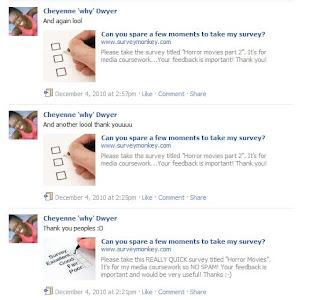 PLANNING Before filming I went on websites to look at exemplar ‘Treatment’ and layouts for meetings. Also, our main prop took a lot of research as there are several methods we came across. YouTube was very helpful because we could watch tutorials on how to make the fingers using latex and clay moulds. This was one method that we tried. This included using sculpting clay, Ben Nye blood, make-up and latex.
PLANNING Before filming I went on websites to look at exemplar ‘Treatment’ and layouts for meetings. Also, our main prop took a lot of research as there are several methods we came across. YouTube was very helpful because we could watch tutorials on how to make the fingers using latex and clay moulds. This was one method that we tried. This included using sculpting clay, Ben Nye blood, make-up and latex. 

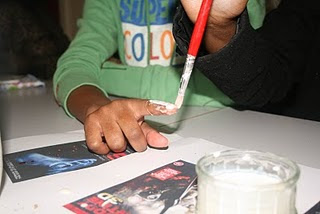 However, we attempted this particular method but we found difficulty in the numbers of finger we could actually make and how we would heat the clay up. Using clay to make the fingers was too long and would have slowed down the process of filming. Also, the clay moulds didn't take the shape of the fingers very well this may have been due to us not moulding the clay round our fingers properly. Therefore, we decided to try making a mould of our actual fingers by layering a nd heating latex onto our fingers, until it became thick enough to take the form of our fingers. We then finished it and gave it a realistic look by adding foundation to the skin, stuffing the inside of the mould and then using stage flood to give it a severed finger effect. http://bluwhisky.blogspot.com/2010/10/props-preparation.html
However, we attempted this particular method but we found difficulty in the numbers of finger we could actually make and how we would heat the clay up. Using clay to make the fingers was too long and would have slowed down the process of filming. Also, the clay moulds didn't take the shape of the fingers very well this may have been due to us not moulding the clay round our fingers properly. Therefore, we decided to try making a mould of our actual fingers by layering a nd heating latex onto our fingers, until it became thick enough to take the form of our fingers. We then finished it and gave it a realistic look by adding foundation to the skin, stuffing the inside of the mould and then using stage flood to give it a severed finger effect. http://bluwhisky.blogspot.com/2010/10/props-preparation.htmlwe also had a proffesional special effects maker to come in and show us how to make up, this was very usefull.
http://bluwhisky.blogspot.com/2010/11/professional-latex-making.html
Location During the planning process we was evaluating the best place for use to shot or teaser trailer. Because our trailer is a teaser trailer we wanted to give as little away as possible.
Trailer We shot our trailer in several locations inside our college. We tried to film in places where the audience would not realise it is a college. Our close up shots of the mouth and fingers was shot in front of a red door. This showed continuity because red s a colour that appears constantly throughout the trailer. Our shots of our weapons, football and fingers in the sink. The location we shot theses scenes in was in the janitor’s cupboard, it gave a haunted, dirty feel to the shoot. If we had shot on a table it would looked too cleans and not fit into the horror genre. The janitor’s cupboard is really creepy and something that is used in many horror films. We didn’t shoot in the classroom because we felt it was too clean. Also the classroom had the large blue screen at the back of the room, this made shooting limited, that’s why we choose to only have one shot in the classroom.
Poster For our poster again we didn’t want to give away too much. We choose to take the picture in front of a glass door in college. Again we used a red door to keep the colour red consistently throughout our media products. The best thing about this glass is that it had thin strips of wire going horizontally and vertically through the glass. This gave a sense of imprisonment, also our main killer being behind the ‘trapped’ glass made you feel like she’s luring you into a trap.
Magazine For our magazine we shot the photographs in numerous places but decided the picture in the classroom was the best. This is because we were given the use of a soft box which allowed use to produce professional looking pictures. The blue screen was not a problem for the photograph because we darken the area around our actress, this made the photograph look like it was shot on a black screen. Different locations we tried included, classroom, corridor, floor and outside.
Time management
PRODUCTION During filming we saved a lot of time setting up footage because we became very familiar with how to set up the equipment such as lights and camera correctly so the majority of the time it was set up in about 5 – 10 minutes. We always had two people setting up footage just in case something is dropped. During filming we always had two people on set. One was filming or taking pictures and the other was directing, the pictures below are examples this. Any problems we had we asked the teacher or assistant to help us solve.
http://bluwhisky.blogspot.com/2010/11/how-we-filmed.html
http://bluwhisky.blogspot.com/2010/12/equipment-used-during-process.html

 Whilst filming our footage for out trailer we used the technique of counting in and out. We found this useful because it clearly shows you were the footage starts and finishes.
Whilst filming our footage for out trailer we used the technique of counting in and out. We found this useful because it clearly shows you were the footage starts and finishes. When filming we learnt that lighting is the key element. Having the set well lite is important to make sure everything is shown clearing and well shot. In good lighting it is also very clear and see if what your filming is in focus. When filming it is also important to make sure that the set is evenly lite. Its iimportant to make sure the set is evenly lite toavoid shadows on photographs or film. The image below shows the ideal lighting to prevent shadows.
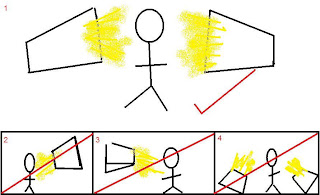
Focusing When using the camera we did have troubles focusing when we first started filming. When your so focused on just filming and getting the shots you forgot about focusing the camera. When we learnt the importance of focusing the camera when we had to re film parts of the footage. One effective way to focus when filming was to press the button circled in red.
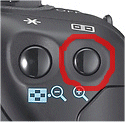 This allowed you to zoom in to specific parts of the footage and focus the lens at the centre which lead to a clearer shot over all. This method is manual focusing.
This allowed you to zoom in to specific parts of the footage and focus the lens at the centre which lead to a clearer shot over all. This method is manual focusing. 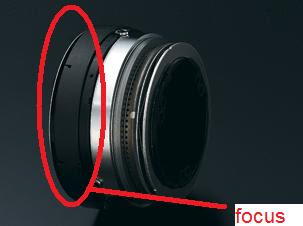
Health and safety was very important during filming because we were using very heavy equipment and specialist make up equipment. When setting up the lights, as a group we assembled the lights on to the tripod and made sure they were firmly in place, we often ask nearby teachers or support staff to double check if it was securely in place. We also did this when assembling cameras onto the tripod. We filming or taking photographs we made sure each set was clear of wires because many people would be pacing by. When using specialist makeup products we tested it on a part of the models skin and waited for 10 minutes to make sure there was no allergic reaction before continuing. We did this for products such a latex and fake blood.
POST-PRODUCTION Editing When researching horror trailers, we noticed that many on them were heavily editing fast, sharp cuts and special effects. This effect helps to create a fear effect to those who are watching it. We always noticed that many teaser trailers are short and snappy, giving the audience a glimce of the potential movie. All these factors help create the perfect teaser trailer. We watched several trailers on youtube to see our the effects were done. To edit shots of our teaser trailer we used Final Cut Pro. For our poster and magazine cover we used Photoshop.
 The two screens allowed us to make edits and changes on one and then view the footage on the other screen.
The two screens allowed us to make edits and changes on one and then view the footage on the other screen. 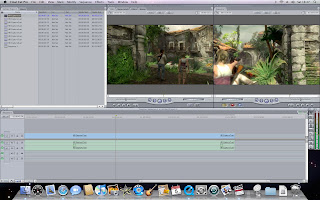 There were filters that we also used to alter the lighting of some shots and add tints to the shots of our victim. As seen in the image below there is a greenish tint on the shot and this was to give it a 'filmy' effect and we thought was more effective than the clear, plain previous shot that was recorded.
There were filters that we also used to alter the lighting of some shots and add tints to the shots of our victim. As seen in the image below there is a greenish tint on the shot and this was to give it a 'filmy' effect and we thought was more effective than the clear, plain previous shot that was recorded.  To get the font for our text we used www.defont.com, this allowed us to view a database of different and free to download texts. Our text we downloaded was corpse.
To get the font for our text we used www.defont.com, this allowed us to view a database of different and free to download texts. Our text we downloaded was corpse.Sound As a group we discussed the key sound we wanted our trailer to have and what impact we want it to have on the audience. We wanted our soundtrack to be very tension so the audience felt drawn to the trailer. As a group we thought racing heartbeat mixed with classical instruments could create this effect. We then contacted a friend in college who worked in the music department to help us put this piece together. He used the software 'Logic' to create the background music. A key element of producing the sound is that it was in sync with the trailer and during process, we had to have the trailer running to make sure the music was in sync. We wanted the trailer to start of calm then build up with high tension to match the quick cutting of the shots and finale scream, therefore the sound ending with an anti-climax. Learning how to make a bacground score was a real geeking out stage of production, because we learnt and explored concepts we are not normally used to.
Memory card
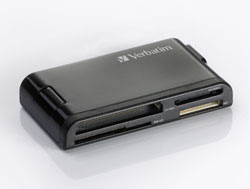 During filming many of our pictures and footage was saved oto a memory card. This memory card was then put into a Verbatim memory card reader which was then plugged in the mac which then allowed us to transfer footage and pictures from the card to the mac so we could continue editing and processing.
During filming many of our pictures and footage was saved oto a memory card. This memory card was then put into a Verbatim memory card reader which was then plugged in the mac which then allowed us to transfer footage and pictures from the card to the mac so we could continue editing and processing.  Facebook - we posted the youtube link on Facebook and because many of the people are the age group we are targeting and who were likely to have filled out the questionnaire. They would be able to comment on what they thought was effective and whether this was what they were looking for in a horror teaser trailer. Posting the videos on people’s profile would effectively attract more people to watch the trailer. By this the trailer is gaining more publicity. This helps to create a ‘buzz’ around the film. Facebook was key to gaining feedback and views from our audience. The internet is a key in any aspect of media because it creates a global network for easy communication.
Facebook - we posted the youtube link on Facebook and because many of the people are the age group we are targeting and who were likely to have filled out the questionnaire. They would be able to comment on what they thought was effective and whether this was what they were looking for in a horror teaser trailer. Posting the videos on people’s profile would effectively attract more people to watch the trailer. By this the trailer is gaining more publicity. This helps to create a ‘buzz’ around the film. Facebook was key to gaining feedback and views from our audience. The internet is a key in any aspect of media because it creates a global network for easy communication. 
Question 3 - What have you learned from your audience feeback?
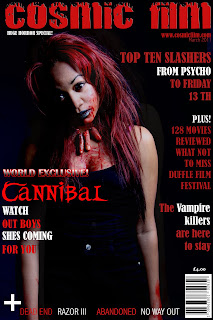

 The colour scheme was the overall comment about the poster and the fingers were really piercing and stood out for most of the audience which shows that the fingers being an iconic item throughout the main and ancillary products has been a success.
The colour scheme was the overall comment about the poster and the fingers were really piercing and stood out for most of the audience which shows that the fingers being an iconic item throughout the main and ancillary products has been a success. The overall comments about the trailer were good. Some people said that they liked it short and kept the audience wanting more, although for some the teaser trailer was too short and a few more seconds could have been added on to it. The trailer was also posted on twitter to get more feedback form a wider audience. Here is some of what was said:


This video contains people's feedback and initial thoughts on the teaser trailer:
- Overall, the audience were very taken by the effectiveness of the fingers and with the fingers being featured in all the media products which made the trailer recogniseable and the main character.
- The consistent use of Red brought the quality of the magazine down.
- The trailer could have been longer to give more of the storyline and create more suspense.
Question 2 - How effective is the combination of your main product and ancillary texts?


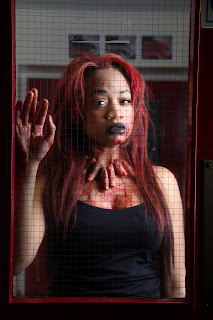
 The wide eyed, 'creepy' stare that both Hannibal Lecter
The wide eyed, 'creepy' stare that both Hannibal Lecter 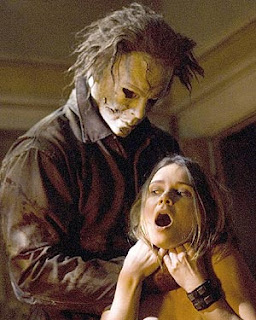
Fingers For our media trailer we wanted to create something that the audience would remember our trailer by, we wanted to create something that would become iconic to ‘Cannibal’. This is where we created the fingers. Due to our leading actress being a women it is stereotyped that women always we necklaces. It was then our challenge to that this concept and adapt it to our horror theme. Since our actress was a cannibal we thought it would we right for to have the fingers of her victims around it neck, this would be like reminder of all the people she has killed
.  We used the fingers in our magazine, poster and trailer to create a sense of continuity. The costume of the actress was kept the same so identification could be made throughout the main product and the ancillary texts. This and the fingers would help the audience to link our teaser trailer, poster and magazine together. Linking the three products together with the same costume and fingers n each helped to create a buzz about the movie. It would make the audience want to know how she got the fingers and why.In the above photographs you can see that we used the fingers throughout the filming and photographic scenes and even in the shots that were not used.We wanted the fingers to be iconic to the film. we wanted to create and effect that you can recognise without even seeing the killer. We have seen this done before in films such as Jason's hockey mask in Friday 13th and the infamous Scream mask.
We used the fingers in our magazine, poster and trailer to create a sense of continuity. The costume of the actress was kept the same so identification could be made throughout the main product and the ancillary texts. This and the fingers would help the audience to link our teaser trailer, poster and magazine together. Linking the three products together with the same costume and fingers n each helped to create a buzz about the movie. It would make the audience want to know how she got the fingers and why.In the above photographs you can see that we used the fingers throughout the filming and photographic scenes and even in the shots that were not used.We wanted the fingers to be iconic to the film. we wanted to create and effect that you can recognise without even seeing the killer. We have seen this done before in films such as Jason's hockey mask in Friday 13th and the infamous Scream mask.
In the pictures above you can see a series of pictures of the scream from the movie and posters. The picture with (*) on it was were the horror movie scream originated from. The painting was created between 1893 – 1910 by the Norwegian artist Edward Munch. The writers and producers of scream have created the iconic effect of the scream mask that can be recognised aware. On Halloween people often dress up as scream with the mask on, this has helped the scream mask and black cape become recognisable worldwide. Colour Theme

Access via smartphones such as blackberry and the iPhone is essential amongst our target audience.
 Although the we are able to view the poster on a smartphone the bigger fonts are more noticable than the small font. However, the picture is still central which what we want our audience to look at. Traditional means of advertising such as billboards, magazines etc... As well as the target audience using billboards and other traditional means of advertising we are also bringing in a mass audience.
Although the we are able to view the poster on a smartphone the bigger fonts are more noticable than the small font. However, the picture is still central which what we want our audience to look at. Traditional means of advertising such as billboards, magazines etc... As well as the target audience using billboards and other traditional means of advertising we are also bringing in a mass audience. 




